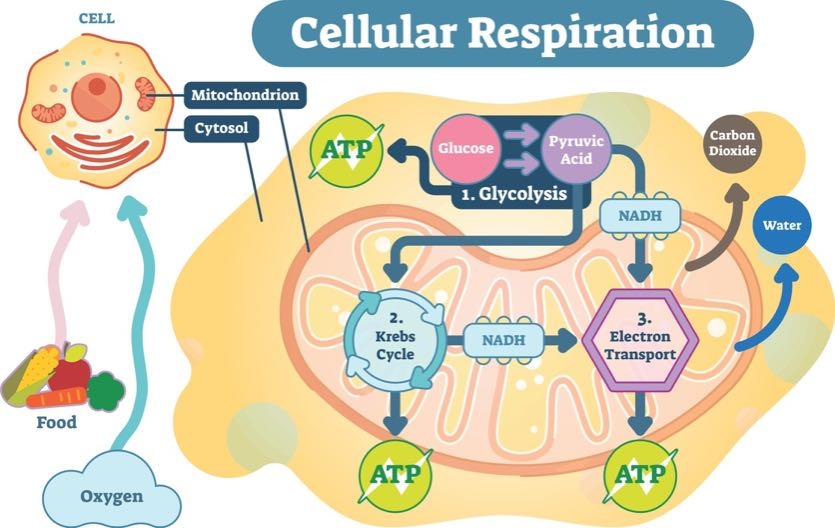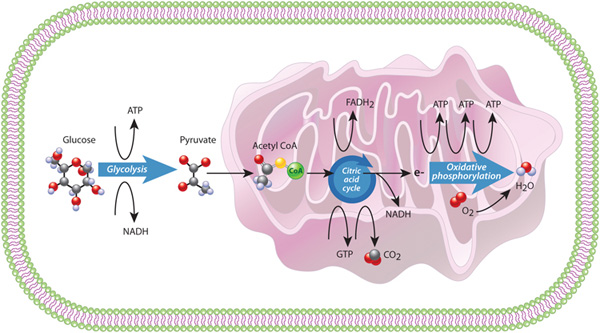Describe How Cells Use Energy to Do Work
Now its back to being ADP and is ready to store the energy from respiration by bonding with a 3rd phosphate group. A fuel cell consists of two electrodesa negative electrode or anode and a positive electrode or cathodesandwiched around an electrolyte.

Understanding Atp 10 Cellular Energy Questions Answered Ask The Scientists
As we have just seen cells require a constant supply of energy to generate and maintain the biological order that keeps them alive.

. Can some cellular processes be done without this molecule. A summary of the three types of photoelectric cells. This energy is derived from the chemical bond energy in food molecules which thereby serve as fuel for cells.
This is the use of exergonic processes to drive an endergonic one. ATP stored energy produced by respiration for use by proteins around the cell to do cellular work. The structure of ATP includes the sugar ribose with the nitrogenous base adenine and a chain of three phosphate groups.
Fuel cells work like batteries but they do not run down or need recharging. Sugar is a good source of energy but cells cant directly use it to do work. Describe the structure of ATP and identify the major class of macromolecules to which ATP belongs.
The solar panel is made up of two main parts the solar cell or cells that capture energy from sunlight and turn it into electricity and an inverter which converts direct current DC power to. An object possessing mechanical energy has both kinetic and potential energy although the energy of one of the forms may be equal to zero. A book sitting on a table has potential energy.
Cells obtain energy to do work through energy coupling. Our bodies primarily use sugars broken down from carbohydrates for energy but if sugar levels drop in the bloodstream cells use fats and if needed proteins. Describe the primary structures in plant cells.
To energy-requiring processes Cells use energy for. Describe the primary structures in animal cells. The main reactants are glucose and oxygen while the main products are carbon dioxide water and ATP.
The study of the energy transformations that take place in living organisms. The biochemical pathways responsible for energy are ultimately responsible for the formation of a chemical called adenosine triphosphate ATP derived from adenosine diphosphate ADP. When the cell needs energy to do work ATP loses its 3rd phosphate group releasing energy stored in the bond that the cell can use to do work.
A moving car has kinetic energy. They produce electricity and heat as long as fuel is supplied. Explain how plant cells make energy for cellular processes.
In fact the Sun is the ultimate source of energy for almost all cells because photosynthetic prokaryotes algae and plant cells harness solar energy. Energy in ATP molecules is easily accessible to do work. Therefore the sugar must first be converted into a more usable form and that usable form is ATP.
1 Photoconductivelight increases the flow of electrons and reduces the resistance. 2 Photovoltaiclight makes electrons move between layers producing a voltage and a current in an external circuit. Cellular respiration is a type of metabolic pathway that breaks down glucose to make adenosine triphosphate or ATP.
In a process called cellular respiration chemical energy in food is converted into chemical energy that the cell can use and stores it in molecules of ATPWhen the cell needs energy to do work ATP loses its 3rd phosphate group releasing energy stored in the bond that the cell can use to do work. Photosynthesis in cells is another type of metabolic pathway that organisms use to make sugar. A fuel such as hydrogen is fed to the anode and air is.
A fuel cell consists of two electrodesa negative electrode or anode and a positive electrode or cathodesandwiched around an electrolyte. Fuel cells work like batteries but they do not run down or need recharging. Examples of the types of work that cells need to do include building complex molecules transporting materials powering the motion of cilia or flagella and contracting muscle fibers to create movement.
The transport synthesis and breakdown of nutrients and molecules in a cell require the use of energy. Sugars are particularly important fuel molecules and they are oxidized in small steps to carbon dioxide CO 2 and water Figure 2-69. 3 Photoemissivelight knocks electrons from a cathode to an anode making.
In animal cells the energy convert ADP to ATP comes. The capacity to do work. Energy is obtained from extracellular sourcesThe process of photosynthesis by producers such as algae and green plants can convert light energy into chemical.
They produce electricity and heat as long as fuel is supplied. The complete set of chemical reactions that occur in living cells. Todays most common PV devices use a single junction or interface to create an electric field within a semiconductor such as a PV cell.
They work by transforming sunlight into electricity through the use of photovoltaic cells. Cells require energy to perform work. If you move the car up a mountain it has kinetic and potential energy.
Chemical work Mechanical work Electrochemical work Reactants describe Energy Enzymes CoenzymesCofactors Products What molecule is the only one directly used by cells to perform work. In a single-junction PV cell only photons whose energy is equal to or greater than the band gap of the cell material can free an. ADP and ATP constantly convert back and forth in this manner.
Explain the role of each structure in plant cells.

Cell Energy Cell Functions Learn Science At Scitable

Understanding Atp 10 Cellular Energy Questions Answered Ask The Scientists

No comments for "Describe How Cells Use Energy to Do Work"
Post a Comment